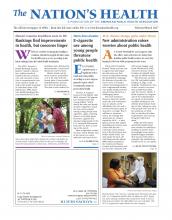More than 20 million Americans may have lab tests showing kidney disease, and rates are growing among adults. Kidney damage can cause waste to build up in the body, and is linked to heart disease and other health problems. In advance of March’s observance of National Kidney Month, The Nation’s Health spoke with Griffin Rodgers, MD, MACP, director of the National Institute of Diabetes and Digestive and Kidney Diseases, about kidney disease risks and steps for prevention.
Who is at greatest risk for kidney disease and why?
People at greatest risk for chronic kidney disease, or CKD, are people who have diabetes, high blood pressure, cardiovascular disease or a family history of kidney failure. Diabetes and hypertension, at least in this country, are the leading causes of kidney damage. Nearly 1 in 4 people with diabetes has CKD, while about 1 in 5 with hypertension has CKD.
Research also shows that there’s a correlation between heart disease and kidney disease. People who have cardiovascular disease are at higher risk for developing kidney disease. Conversely, people with kidney disease are at a high risk for developing cardiovascular disease.
Prevalence of kidney disease has been growing among U.S. adults, especially among people who are ages 60 and older. Why is this?
The development of kidney disease due to diabetes…is the most common cause. More people, unfortunately, are developing diabetes at earlier ages and living long enough with diabetes to develop kidney disease.
In addition, kidney function decreases with age. Some decline may be a natural part of the aging process. As people get older, the number of filtering units in the kidney begin(s) to decrease. The overall amount of kidney tissue may decrease.
Older people also are more likely to be taking medications that we now know they may be more sensitive to.
For example, non-steroidal anti-inflammatory drugs like ibuprofen and naproxen can cause damage to the kidney. Many older adults are using that for arthritis. Certain types of antibiotics can also cause damage to the kidney.
NIDDK partnered with our sister agency, the National Institute on Aging, or NIA, about a year ago to remind older Americans about the importance of protecting their kidneys.
We think it’s important to educate the aging population and their health care providers about ways to prevent kidney injury, (to encourage) older adults to know their level of kidney function, and to be mindful of these particular drugs…as an important step to reduce the growing rates of kidney injury among older U.S. citizens.

Rodgers
What other populations have higher rates of kidney disease?
Kidney disease disproportionately affects certain racial and ethnic groups. For example, African-Americans, Hispanics and Latinos and American Indians have a higher or greater risk for chronic kidney disease. Kidney disease affects 1 of every 6 African-American adults in the U.S., and that number is about the same for Hispanic and Latino adults.
It’s estimated that kidney disease may affect, in the general population, about 1 in 10 adults, just to put that in perspective.
The greater risk…is mostly because these groups tend to have higher rates of diabetes and hypertension, or high blood pressure. It’s important, though, that the rate at which they move from chronic kidney disease to end-stage kidney disease kidney failure is different.
African-Americans with CKD, for example…are about 3.5 times more likely to go on to develop kidney failure in comparison to Caucasians. In the case of American Indians, that number is about 1.8 times more likely, and among Hispanic and Latinos, it’s about 1.5 times more likely.
NIDDK is funding research to try to understand what the basis of this excessive incidence and prevalence of both chronic kidney disease and end-stage kidney disease in these populations. As we know, most chronic diseases have a mixture of the genetic predisposition as well as environmental factors.
Do people with kidney disease usually know that they have it or does it go undetected? What are the symptoms?
Unfortunately, this is one of these silent diseases. Early kidney disease may have no symptoms at all. Many people, in fact, don’t have symptoms until their kidneys are severely damaged or they’re nearing kidney failure.
That’s why testing is critical for people who have diabetes, high blood pressure, cardiovascular disease or a family history. The tests are quite simple, a blood test and a urine test. Early detection and appropriate treatment of early chronic kidney disease is important for both preventing or delaying kidney failure.
Most people don’t have symptoms. However, as disease progresses, kidney function decreases, fluid may accumulate, generally in the extremities, and weight may increase. High blood pressure may worsen.
The kidneys also have a very important role in producing a hormone that stimulates the bone marrow to produce red blood cells. As production of this hormone — erythropoietin — decreases, anemia may develop.

NIDDK Director Griffin Rodgers, in his lab in the NIH's Clinical Research Center, focuses on his research on sickle cell disease. NIDDK’s research goals include preventing kidney disease among Americans. More than 20 million people in the U.S. have kidney disease, and rates are increasing.
Photos courtesy NIDDK
How can people prevent kidney disease?
Healthy lifestyle choices are one of the best ways to prevent kidney disease, if it’s caused by diabetes or high blood pressure. We recommend to make healthier food choices and to be physically active. Make that a part of your routine. And if you’re overweight or obese, work with your health care provider or a dietitian to create a realistic weight loss plan.
In addition to what you eat and how much you exercise, getting enough sleep is also important. Aiming for seven or eight hours of sleep each night and trying to stay on a sleep and wake schedule every day are both important for maintaining a healthy weight. And, we now know that not getting enough sleep can have adverse effects on metabolism and blood pressure and other things.
The final behaviors that we recommend: Stop smoking, limit alcohol intake and try to explore stress-reducing activities, like physical activity, for example.
How is NIDDK working to educate and reach people who might be at risk for kidney disease?
In 2000, NIDDK established the National Kidney Disease Education Program, or NKDEP. NKDEP aims to reduce the morbidity and mortality associated with kidney disease by promoting evidence-based interventions to improve the understanding, detection and management of kidney disease.
NKDEP works in collaboration with a wide range of government and nonprofits and health care organizations to raise awareness among people at risk for chronic kidney disease about the need for the tests that we mentioned, to educate people with CKD about how to manage their disease. NKDEP also provides information, training and tools to help health care providers.
The goal here is to really educate all of the health professionals in the primary care setting about how to identify and manage CKD.
NIDDK has been partnering with a nursing sorority, Chi Eta Phi — and now more than 140 or so faith organizations throughout the country — to hold Kidney Sundays events through church health ministries during March. We have a Kidney Sundays toolkit, which includes educational materials and event planning tips for people to conduct their Kidney Sundays events throughout the year to raise awareness in their communities about kidney risk.
For NIDDK resources on identifying and managing patients, visit www.niddk.nih.gov/health-information/kidney-disease. For the Kidney Sundays toolkit, visit bit.ly/kidneysundays.
- Copyright The Nation’s Health, American Public Health Association









